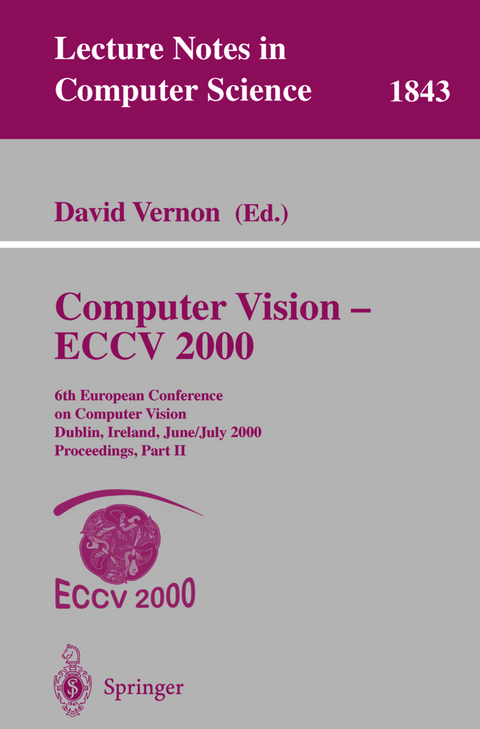Computer Vision - ECCV 2000
Springer Berlin (Verlag)
978-3-540-67686-7 (ISBN)
Recognition & Modelling I.- Partitioned Sampling, Articulated Objects, and Interface-Quality Hand Tracking.- Real-Time Tracking of Multiple Articulated Structures in Multiple Views.- Pedestrian Detection from a Moving Vehicle.- Vision-Based Guidance and Control of Robots in Projective Space.- Stereoscopic Vision.- A General Method for Unsupervised Segmentation of Images Using a Multiscale Approach.- Image Segmentation by Nonparametric Clustering Based on the Kolmogorov-Smirnov Distance.- Euclidean Group Invariant Computation of Stochastic Completion Fields Using Shiftable-Twistable Functions.- Recognition & Modelling / Stereoscopic Vision / Texture, Shading, & Colour.- Bootstrap Initialization of Nonparametric Texture Models for Tracking.- Quasi-Random Sampling for Condensation.- Tracking Discontinuous Motion Using Bayesian Inference.- Direction Control for an Active Docking Behaviour Based on the Rotational Component of Log-Polar Optic Flow.- The Construction of 3 Dimensional Models Using an Active Computer Vision System.- Significantly Different Textures: A Computational Model of Pre-attentive Texture Segmentation.- Calibrating Parameters of Cost Functionals.- Coupled Geodesic Active Regions for Image Segmentation: A Level Set Approach.- Level Lines as Global Minimizers of Energy Functionals in Image Segmentation.- A Probabilistic Interpretation of the Saliency Network.- Layer Extraction with a Bayesian Model of Shapes.- Model-Based Initialisation for Segmentation.- Statistical Foreground Modelling for Object Localisation.- Nautical Scene Segmentation Using Variable Size Image Windows and Feature Space Reclustering.- A Probabilistic Background Model for Tracking.- On the Performance Characterisation of Image Segmentation Algorithms: A Case Study.- Statistical Significance as an Aid to System Performance Evaluation.- New Algorithms for Controlling Active Contours Shape and Topology.- Motion Segmentation by Tracking Edge Information over Multiple Frames.- Data-Driven Extraction of Curved Intersection Lanemarks from Road Traffic Image Sequences.- Tracking and Characterization of Highly Deformable Cloud Structures.- Calibration.- A Unifying Theory for Central Panoramic Systems and Practical Implications.- Binocular Self-Alignment and Calibration from Planar Scenes.- The Rôle of Self-Calibration in Euclidean Reconstruction from Two Rotating and Zooming Cameras.- Hand-Eye Calibration from Image Derivatives.- Medical Image Understanding.- Multimodal Elastic Matching of Brain Images.- A Physically-Based Statistical Deformable Model for Brain Image Analysis.- Minimal Paths in 3D Images and Application to Virtual Endoscopy.- Calibration / Medical Image Understanding / Visual Motion.- Kruppa Equation Revisited: Its Renormalization and Degeneracy.- Registration with a Moving Zoom Lens Camera for Augmented Reality Applications.- Calibration of a Moving Camera Using a Planar Pattern: Optimal Computation, Reliability Evaluation, and Stabilization by Model Selection.- Multi-view Constraints between Collineations: Application to Self-Calibration from Unknown Planar Structures.- Stereo Autocalibration from One Plane.- Can We Calibrate a Camera Using an Image of a Flat,Textureless Lambertian Surface?.- Underwater Camera Calibration.- On Weighting and Choosing Constraints for Optimally Reconstructing the Geometry of Image Triplets.- Computation of the Mid-Sagittal Plane in 3D Images of the Brain.- Stochastic Tracking of 3D Human Figures Using 2D Image Motion.- Monocular Perception of Biological Motion - Clutter and Partial Occlusion.- 3-D Motion and Structure from 2-D Motion Causally Integrated over Time: Implementation.- Non-parametric Model for Background Subtraction.- Qualitative Spatiotemporal Analysis Using an Oriented Energy Representation.- Regularised Range Flow.- Visual Encoding of Tilt from Optic Flow: Psychophysics and Computational Modelling.- Visual Motion.- IMPSAC: Synthesis of Importance Sampling and Random Sample Consensus.- Egomotion Estimation Using Quadruples of Collinear Image Points.- Geometric Driven Optical Flow Estimation and Segmentation for 3D Reconstruction.- Camera Pose Estimation and Reconstruction from Image Profiles under Circular Motion.
| Erscheint lt. Verlag | 19.6.2000 |
|---|---|
| Reihe/Serie | Lecture Notes in Computer Science |
| Zusatzinfo | XXXVI, 882 p. |
| Verlagsort | Berlin |
| Sprache | englisch |
| Maße | 155 x 235 mm |
| Gewicht | 1503 g |
| Themenwelt | Informatik ► Grafik / Design ► Digitale Bildverarbeitung |
| Mathematik / Informatik ► Informatik ► Software Entwicklung | |
| Informatik ► Theorie / Studium ► Künstliche Intelligenz / Robotik | |
| Schlagworte | 3-D Vision • computer vision • Hardcover, Softcover / Informatik, EDV/Informatik • HC/Informatik, EDV/Informatik • Image Processing • Maschinelles Sehen • Object recognition • pattern recognition • robot • Robot vision • Shading • Stereo • vision systems • visual motion • visual perception |
| ISBN-10 | 3-540-67686-4 / 3540676864 |
| ISBN-13 | 978-3-540-67686-7 / 9783540676867 |
| Zustand | Neuware |
| Haben Sie eine Frage zum Produkt? |
aus dem Bereich




